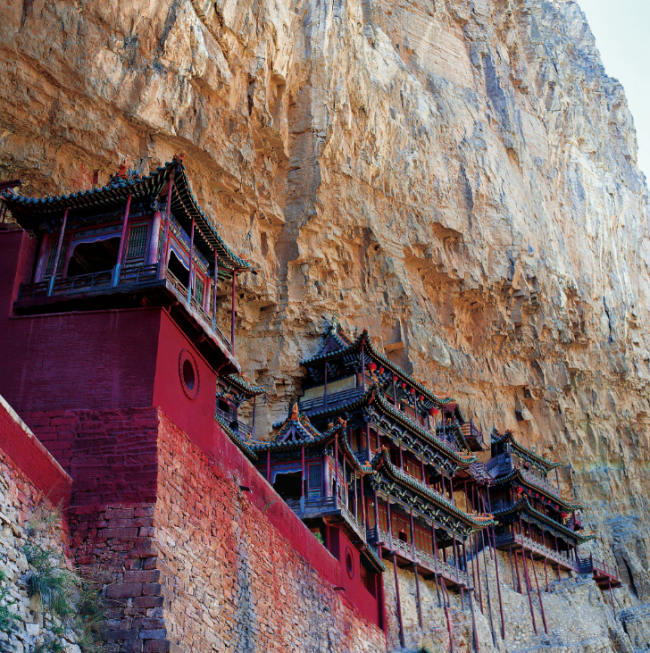Ancient building treasures in Shanxi
“Ancient Chinese Civilization and Good Sceneray in Shanxi”。Shanxi has a long and splendid history and an endless cultural context. It is the province with the largest number of ancient architectural relics in China. With complete sequence of times, numerous categories and complete shapes, Shanxi is known as the "treasure house of ancient Chinese architecture". There are 2,8027 ancient buildings in existence, including 518 early wooden buildings in the Yuan Dynasty and before, accounting for more than 80% of the early ancient buildings in China.Today Xiaobian will introduce you to a few historical and ancient architectural attractions in Shanxi Province!

1.Foguang Temple
Foguang Temple is located on the mountainside of Foguang Mountain, Doucun Town, Wutai County, Shanxi Province. With a history of more than 1,300 years, it is one of the only four ancient wooden buildings built during the Tang Dynasty. There are many Buddhist heritages in the temple, for which it’s called “Asian Buddha's Light”. The buildings, sculptures, murals, and inscriptions of the Tang Dynasty in Foguang Temple are of high historical and artistic value, and are known as the “Four Wonders”. Occupying an important position in the history of architecture in China and even in the whole world, the temple is known as “China's No. 1 National Treasure”.

2. Yingxian Wooden Pagoda
Yingxian Wooden Pagoda, also named the Sakyamuni Pagoda of Fogong Temple, is located in Yingxian County, Shanxi Province. It is regarded as one of the “Three Great Pagodas in the World” together with the Eiffel Tower in France and the Leaning Tower of Pisa in Italy. Being the only one pure wooden Pagoda existing in China, Yingxian Wooden Pagoda is also the tallest, most complex, and most outstanding wooden structure existing in the world. The Yingxian Wooden Pagoda is similar in height to the medieval Turkish Galata Tower, equivalent to a 22-story modern building. Yingxian Wooden Pagoda was recognized as “the Tallest Wooden Pagoda in the World” by Guinness World Records in 2016.

3.Jinci Temple
Jinci Temple, which is located 25 km southwest of Taiyuan at the foot of Xuanweng Mountain, was built as a memorial to Shuyu, the son of King Wu of the Western Zhou Dynasty. The ancestral hall was later renamed “Jin King Temple”, or "Jinci Temple" for short. Jinci Temple is the earliest surviving royal garden in China, known as the “Little Jiangnan” in Shanxi. There are 98 buildings, 110 statues, 300 steles, and 37 cast artworks in the temple, all of which can date back to over 300 years ago. It is a perfect model of the combination of nature and ancestral halls and sacrificial buildings.

4.Huayan Temple
Huayan Temple, the largest temple in the building complex in the Liao- Jin Dynasty in China, was built based on the classic “Huayan Sutra” of the Huayan Sect, one of the seven major sects of Buddhism. The Mahavira Hall in the upper temple is the largest existing Buddhist hall built in the Liao-Jin Dynasty. In the lower temple, there is a famous smiling Bodhisattva with folded palms, which is praised as “Venus in the East”. Unlike most Buddhist temples lying at a traditional north-south orientation in China, Huayan Temple sits west and faces east, embodying the living customs of the Khitan people in the Liao Dynasty who “favor the east and chase the sun for suitable settlements”.

5.Yongle Palace
Yongle Palace is the largest surviving official-style building complex of the Yuan Dynasty in China. It was built to commemorate Lu Dongbin, one of the Eight Immortals of Taoism. As a treasure of ancient Chinese architecture and painting art, Yongle Palace is known as the “Oriental Art Gallery”. A large number of Yuan Dynasty murals are preserved in the palace, for which the palace is considered one of the largest ancient mural art treasure repositories in the world. The overall relocation of the Yongle Palace and its huge murals, and the relocation of the Egyptian Abu Simbel Temple have been once called the two miracles of artificial relocation in the history of world cultural relics.

6.Hanging Temple
Located at the foot of Hengshan Mountain in Shanxi Province, Hanging Temple is the earliest and best-preserved high-altitude wooden cliff building in China. In 2010, it was selected as one of the top 10 precarious buildings in the world by Time Magazine, being as famous as the Gate of Europe in Spain. The whole building of the Hanging Temple is suspended on the right-angle cliff. After more than 1500 years of being blown by wind and hit by rain and experiencing many earthquakes, it still stands tall. Although the inner space of the temple is small, the elements of Confucianism, Taoism, and Buddhism are well combined.

7.Haizhou Guandi Temple
In China, the Guan Gong belief ps three schools—Buddhism, Taoism, and Confucianism. In Caibarién, Cuba's Villa Clara province, the Chamber of Commerce in the local Chinatown places Guan Gong alongside the Mother and Patroness of Cuba “Our Lady of Charity” in their respective shrines to worship. Although there are temples dedicated to Guan Gong all over the world, the largest one is the Haizhou Guandi Temple in Yuncheng City, Shanxi Province, which is known as the “Origin of Guandi Temple” since the Haizhou is the hometown of Guan Gong. The Guandi Temple in Haizhou was first built in the Sui Dynasty and then expanded by the following believers. Then the temple became larger and larger with a total area of 220,000 square meters, which holds a well-deserved title of “the Leading One of Martial Temples”.